Ever seen a dog fart so loud that he scares himself?
I love it when that happens.
It’s a helpful reminder of two key life lessons:
1. Everybody farts.
2. Scaring yourself isn’t always a bad thing.
Think about it:
To scare yourself is to motivate yourself.
To scare yourself is to challenge yourself.
To scare yourself is to understand yourself.
Not that you should do anything dangerous.
I’d hate for you to scare yourself to the point that you wind up in the hospital. Or violate your values. Or contaminate your personal constitution.
The secret is to scare yourself for the right reasons. Here’s how:1. Victory is the great vexation. I don’t know about you, but I’m not scared of failure. Hell, I fail all the time. What petrifies me most is success.
Here’s why: First, you never learn as much about yourself when you’re winning. It’s only through biting the big one that you enter into the arena of self-understanding.
Secondly, success is scary because there’s nothing more terrifying than getting exactly what you want. Think about it: If you do get what you want, you might lose it. Or you might realize it’s not enough. Or you might discover it’s not actually what you (thought) you wanted.
The point is, sometimes it’s easier, safer and more fun to just want things. It’s the getting part that terrifies us.
Finally, the reason success is so scary is because with success comes power, and with power comes responsibility. As a writer, I deal with this on a daily basis. Especially since I’ve been publishing books and blogging for eight years now. People aren’t just reading what I say – they’re actually taking my advice.
I even had a reader email recently to say that one of my blog posts gave her the much-needed final push to end her toxic marriage.
Woops.
Um, you’re welcome?
Jesus. I think I liked it better when the only person reading my blog was my mom. But I guess that’s part of the deal. That’s the price of success. Yikes. Are you more scared of victory or defeat?
2. Give your fear a voice. You think you’re scared? You ain’t seen nothing yet. Try looking into the eyes of the people who matter and honestly sharing why you’re scared. That’ll make you wish you wore a diaper to work.
I tried this during a recent board meeting as the president of my local association. At the onset, I asked everyone to share what they were scared of and why.
Now, as the leader, I went first. “Guys, I’m scared that our chapter has outlived its usefulness. I’m scared we’re approaching irrelevancy quickly. And I’m scared this ship is going down on my watch. Who’s next?”
And for the next few minutes, everyone went around the table and voiced their fears too. It wasn’t pretty, but we made it through the exercise.
The cool part was, even though sharing our individual concerns was scary initially; the simple act of doing so assuaged much of our doubt. And after a healthy, honest discussion, it turned out there wasn’t as much to be scared of as we thought.
Huh. Maybe that’s the secret. Maybe the best way to save yourself from your fears – personally or professionally – is to share them publicly. I wonder how many of your relationships could be saved by an honest exchange of mutual scared-shitlessness. When was the last time you emptied your purse on the table?
3. Pursue the path of wholehearted surrender. As a lifelong control freak, I’ve always found the idea of surrendering to be a terrifying proposition. I guess to me, it always seemed safer to choreograph everything.
Not true. In fact, it’s actually the opposite: He who risks not, risks most.
That’s my next suggestion: Surrendering what you are for what you could become. Not a bad trade. The secret is creating a daily practice to support your surrender. Personally, I recite the following incantation several times a day:
“I expect nothing … I am richly supported … I trust my resources … I am equal to this challenge.”
I’ve found that the stillness created through this breathing exercise softens the blow of the fear. It doesn’t eliminate it. But then again, that’s not the point.
Scaring yourself is about greeting your fear with a welcoming heart – then using its momentum against itself to breathe right through it. And if you can be brave enough to make yourself vulnerable to the process, you’ll initiate a breakthrough.
Either that, or you’ll have a panic attack. Just remember: If you’re not scared, you’re not stretching enough. To change the world is to change your underwear. What are you doing – right now – that requires faith?
4. Never underestimate the scariness of self-questioning. Questions aren’t just questions – they’re catapults. And when asked strategically, they get your hamster wheel moving at full speed to entertain dangerous thoughts.
Also, questions aren’t just questions – they’re swords. And when asked honestly, they penetrate deeper and truer than any old affirmation. Three scary examples from my experience as a writer.
*Instead of posting on a sticky note in my office saying, “Writing is the basis of all wealth,” I ask, “What did you write today?”
*Instead of drawing on a whiteboard with, “Stay focused,” I ask, “Is what you’re doing right now consistent with your number one goal?”
*Instead of writing above my desk, “If you don’t write it down, it never happened,” I ask, “Is everything you know written down somewhere.” See the difference?
It’s about self-confrontation, self-accountability and self-motivation. Doesn’t get much scarier than that. Your challenge is go back to your office and reconsider what’s written on your wall. What questions do you ask yourself every day?
5. Walk through a doorway and let it close behind you. If you stand at the threshold, keeping the door safely ajar, you’ll never make any progress. But if you invite the unsettling echo of the creaking hinge to profoundly penetrate you, I guarantee you’ll scare yourself into doing something worthwhile.
That’s the interesting thing about fear: It intensifies emotion; but it also solidifies commitment. Thus, scaring yourself is a healthy form of self-pressure. Even if it’s as simple as changing your Facebook status from “single” to “in a relationship.” It’s amazing how many positive results can occur when you cross that threshold.
Unless your ex-girlfriend starts leaving vicious comments on your wall about how you’re a the devil. Not cool.
My suggestion: Let the door hit you on the way out. Hard. Right in the ass. Otherwise you’ll never scare yourself into executing what matters. How will communicating that you’re fully committed disturb you into taking action?
6. Administer a heroic dose of reflection. One of the ways my clients use me is as a small group facilitator. It’s a nice break from being the guest speaker, as I don’t have prep as much. Instead, my life is my preparation. All I have to do is show up and make sure people feel heard.
During a recent retreat with forty company leaders, we ran an exercise called “Lifelines.” It required participants to divide their lives into thirds and extract powerful lessons from pivotal moments along the way. Unexpectedly, what amazed me about this process was how uncomfortable it made certain people.
Turns out: Not everybody reflects. For any number of reasons: Some people don’t value reflection. Some prefer not to dwell on the past. Or, some people simply aren’t as introspective as others. On the other hand, some people choose not to reflect – probably subconsciously, I imagine – because they’re scared of what they might learn about themselves.
It’s the same reason people refuse to journal daily. It’s the same reason people in my yoga class refuse to meet their own eyes in the mirror. And it’s the same reason I have stacks of footage from past speeches that I will absolutely never, ever watch.
But maybe that’s the solution. Maybe administering a heroic dose of self-reflection is the only way to scare yourself into the next version of yourself. When was the last time you watched yourself on video?
7. Bear the responsibility for what you’ve become. There’s nothing more existentially agonizing than noticing a part of yourself that you don’t like; and then realizing that you’re the primary reason it’s there. Cognitive dissonance doesn’t just hurt the heart; it scares the soul.
But then again, this might be the best thing that ever happens to you. Maybe reaching the point where you can’t stand yourself anymore is the only way to upgrade. After all, from great suffering comes great awakening. That’s what happened to me: I reached a point where the distaste for who I’d become (finally) scared me enough to change everything.
And I crawled out of the minefield alive. Stumbling but surviving.
My suggestion: Stop hypnotizing yourself. Don’t allow yourself to jump back into the dark hole you’ve made to hide in. Grab your liabilities by the lapel and drag them out into the daylight. As I learned from Mirror of Truth:
“When you eventually take responsibility for what you’ve become, you stop pulling punches, making up mitigating circumstances, and start to understand a little more about yourself. And you realize that you’re not that different from everyone else. You’ve just admitted to yourself that you have a lot of work to do before you’re ready to look at yourself in the mirror again.”
Remember: You are the result of yourself. If you don’t like the final product, go back and run a quality control check on the production process. Even if you pee your pants on the factory floor. Do you have the courage to take full responsibility for everything you think, feel and do, without blaming yourself?
8. Dance on the perimeter of your boundaries. I don’t mean violate them – I mean test their elasticity. Huge difference. One is a gap in integrity; the other is an experiment in flexibility. But that’s the nature of boundaries: You set them for yourself out of an inherent need to preserve your sense of control.
The funny thing is, once you get there – and you realize that you didn’t need to build the wall as high as you originally thought – the music starts to take over. And before you know it, your feet are moving. Your hips are gyrating. And your face hurts from smiling so much.
Sure, your heart’s beating three times faster than normal. But you sort of don’t care. Because you look back at the excessive walls you spend your entire life building for yourself and think, “Well I’ll be damned. Look at me, dancing night away. Guess those bricks weren’t as necessary as I thought.”
Wow. Feeling out of control never felt so good.
Bottom line: You’ve got to extend your arm. Otherwise you’ll never grow into anything better. When was the last time you stretched your boundaries without compromising your foundation?
REMEMBER: Scaring yourself (for the right reasons) is the gateway to personal growth.
I challenge you to look in the mirror, to breathe through the fear and to proceed anyway.
And yes, I know being scared means being uncomfortable.
But uncomfortable people are the only ones who ever change the world.
LET ME ASK YA THIS…
Do you need to wait for Halloween to scare yourself?
LET ME SUGGEST THIS…
For the list called, “100 People (Not) To Listen To,” send an email to me, and you win the list for free!
* * * *
Scott Ginsberg
That Guy with the Nametag
Author, Speaker, Entrepreneur, Mentor
[email protected]
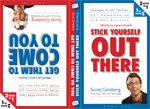 The world’s FIRST two-in-one, flip-flop book!
The world’s FIRST two-in-one, flip-flop book!
Buy Scott’s comprehensive marketing guidebook on Amazon.com and learn how to GET noticed, GET remembered and GET business!

 Few forces in the world burn brighter than a human being’s inherent hunger to contribute.
Few forces in the world burn brighter than a human being’s inherent hunger to contribute.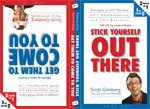 The world’s FIRST two-in-one, flip-flop book!
The world’s FIRST two-in-one, flip-flop book!
 In his final HBO comedy special, seventy-one year old George Carlin walked onto the New York stage to a standing ovation and opened his show with the following comment:
In his final HBO comedy special, seventy-one year old George Carlin walked onto the New York stage to a standing ovation and opened his show with the following comment: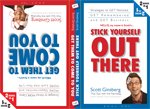 The world’s FIRST two-in-one, flip-flop book!
The world’s FIRST two-in-one, flip-flop book! To trust is to surrender.
To trust is to surrender.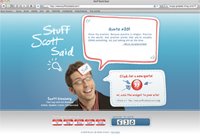 Who’s quoting YOU?
Who’s quoting YOU?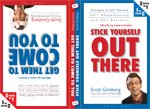 The world’s FIRST two-in-one, flip-flop book!
The world’s FIRST two-in-one, flip-flop book! “How do people feel about using your system?”
“How do people feel about using your system?” Few forces in the world burn brighter than a human being’s inherent hunger to contribute.
Few forces in the world burn brighter than a human being’s inherent hunger to contribute.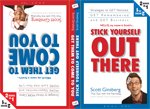 The world’s FIRST two-in-one, flip-flop book!
The world’s FIRST two-in-one, flip-flop book! This year, I celebrated my thirtieth birthday.
This year, I celebrated my thirtieth birthday.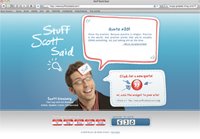 Who’s quoting YOU?
Who’s quoting YOU?